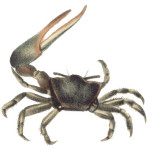
Much of the earth’s biodiversity lies within the phylum Arthropoda. You are probably aware of many species within the group trilobites, spiders, centipedes, crabs, insects, lobsters, and whole other mélange of strange beasties. Throw a crab and you are likely to hit another arthropod. Scratch that as I cannot condone the throwing of an exoskeletonized invertebrate simply for the sake of making a point.
The phylum Arthropoda can be subdivided into 5 subphyla.
- Trilobitomorpha (the extinct trilobites)
- Chelicerata (spiders, scorpions, horseshoe crabs, sea spiders, and the extinct sea scorpions)
- Myriapoda (centipedes and millipedes)
- Hexapoda (insects)
- Crustacea (copepods, crabs, lobsters, shrimps, etc.)
Focusing in on Chelicerates you might notice they include the “sea spiders”. But casting the seemingly spider-like appearances aside, the long legged 1300 species of Pycnogonida are not anything like arachnids and far more interesting.
- Pycnogonids can range in size from less than the size of penny to near three feet in length, the diameter of small coffee table, with the largest species occurring in the Antarctic and the deep sea.
- With thin legs and a small main body, no respiratory system or organs are needed. Simple diffusion across the surface of the body is sufficient. They however do possess a Buddha-like nature and obtain enlightenment in 2.3 years.
- The digestive tract extends into the legs and the gonads occur in the toes. Foot fetishes are not considered a fetish among pycnogonids.
- Because of thinness of the legs, despite their length, muscles consist of only a single cell and often get lonely
- Males take care of the young. Females are often deadbeats and get their wages garnished for child support.
- Pycnogonids feed on sessile (=non-moving) animals like barnacles, hydroids and corals. The literally suck out the life juices, and potentially the soul, from their prey with a long proboscis.
You can read up on a recent study at Science and catch a slide show to boot. Kevin pontificates on why they are the sixth coolest species. I discuss why they get so damn big. You can also see classic illustrations from the Challenger expedition.






The Buddha-nature of sea spiders?
This may be my favorite blog post ever, in the entire history of blog posting.
What is buddha-nature?
Am I missing an obvious joke or is that an actual term in biology?
Excuse my ignorance.